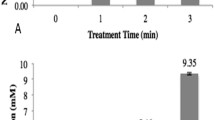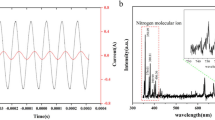Abstract
The underlying mechanisms and biochemical actions responsible for inactivation of pathogenic gram-positive Staphylococcus aureus (S. aureus) and gram-negative Salmonella abony (S. abony) bacteria upon exposure to sub-atmospheric plasma has been investigated. Reduction in colony forming units of the bacteria is established in 60 min and 40 min for S. aureus and S. abony respectively via 6-log reduction curves. The percentage change in reactive oxygen species, such as •OH and H2O2 formed on bacterial membrane during plasma exposure are analysed using spectroflurometer. S. aureus exhibited a significant increase of 324.23% and 1554.84% in •OH and H2O2 radicals respectively. Whereas, 98.14% and 54.49% increase in •OH and H2O2 radicals respectively was observed in S. abony. The oxidation and degradation of DNA is analysed using an ultra violet visible spectrophotometer. The leakage of proteins, lipids, and nucleic acid molecules due to plasma exposure is studied by Attenuated Total Reflectance Fourier-transform infrared spectroscopy (ATR-FTIR). The alteration of secondary protein structure on the cell membrane is observed using Circular Dichroism. Upon exposure to plasma, S. aureus shows a secondary protein structural transition from α-helix (2.4%), β-sheet (78.3%) mixture to modified β-sheet structure (0% α-helix, 79.1% β-sheet). Whereas, S.abony shows a transition from α-helix (1%), β-sheet (64.9%) mixture to modified β-sheet structure (0% α-helix, 74.5% β-sheet). The bacterial morphological study (swelling/shrinking) done using Field Emission Scanning Electron Microscopy (FE-SEM) reveals the deformation of cell membrane. Above findings pave the way for a better understanding of the processes of antimicrobial inactivation strategies when the plasma sterilization process is employed.


















Similar content being viewed by others
Availability of Data and Materials
The data that support the findings of this study are available from the corresponding author upon reasonable request.
References
Haque M, Sartelli M, McKimm J, Bakar MA (2018) Health care-associated infections–an overview. Infect Drug Resist 11:2321
Sakudo A, Yagyu Y, Onodera T (2019) Disinfection and sterilization using plasma technology: fundamentals and future perspectives for biological applications. Int J Mol Sci 20(20):5216
Fiebrandt M, Lackmann JW, Stapelmann K (2018) From patent to product? 50 years of low-pressure plasma sterilization. Plasma Processes Polym 15(12):1800139
Rossi F, Kylián O, Rauscher H, Gilliland D, Sirghi L (2008) Use of a low-pressure plasma discharge for the decontamination and sterilization of medical devices. Pure Appl Chem 80(9):1939–1951
Lerouge S, Wertheimer MR, Yahia LH (2001) Plasma sterilization: a review of parameters, mechanisms, and limitations. Plasmas Polym 6:175–188
Zhang L, Wang H, Luo H (2020) Uncovering the inactivation kinetics of Escherichia coli in saline by atmospheric DBD plasma using ATR FT-IR. Plasma Processes Polym 17(9):1900197
Shi X, Liu S, Jiang R, Chen J, Jin S, Mei D, Cullen PJ (2022) Development and characterization of touchable air plasma jet device for inactivation of oral bacteria. Results Phys 36:105405
Moisan M, Barbeau J, Crevier MC, Pelletier J, Philip N, Saoudi B (2002) Plasma sterilization. Methods and mechanisms. Pure Appl Chem 74(3):349–358
Lee GJ, Sim GB, Choi EH, Kwon YW, Kim JY, Jang S, Kim SH (2015) Optical and structural properties of plasma-treated Cordyceps bassiana spores as studied by circular dichroism, absorption, and fluorescence spectroscopy. J Appl Phys 117(2):023303
Pompl R, Jamitzky F, Shimizu T, Steffes B, Bunk W, Schmidt HU, Morfill GE (2009) The effect of low-temperature plasma on bacteria as observed by repeated AFM imaging. New J Phys 11(11):115023
Seo H, Hong J, Kim T, Sung D, Moon E (2019) Super-antibiofilm effect of N2 plasma treated buffer (NPB) against plant pathogenic bacterium. J Biol Eng 13(1):1–8
Singh MK, Ogino A, Nagatsu M (2009) Inactivation factors of spore-forming bacteria using low-pressure microwave plasmas in an N2 and O2 gas mixture. New J Phys 11(11):115027
Singh MK, Nagatsu M (2015) Large-volume plasma device with internally mounted face-type planar microwave launchers for low-temperature sterilization. Plasma Med 5(2–4):159
Nicol MJ, Brubaker TR, Honish BJ, Simmons AN, Kazemi A, Geissel MA, Kirimanjeswara GS (2020) Antibacterial effects of low-temperature plasma generated by atmospheric-pressure plasma jet are mediated by reactive oxygen species. Sci Rep 10(1):1–11
Li X, Tao X, Yin Y (2009) An atmospheric-pressure glow-discharge plasma jet and its application. IEEE Trans Plasma Sci 37(6):759–763
Zabidi NZA, Zaaba SK, Sut KE, Mohamad CWSR, Masiman RI (2021) A brief review on atmospheric air plasma. J Phys: Conf Ser 2071(1):012004
Šimončicová J, Kryštofová S, Medvecká V, Ďurišová K, Kaliňáková B (2019) Technical applications of plasma treatments: current state and perspectives. Appl Microbiol Biotechnol 103:5117–5129
Shrivastava SR, Shrivastava PS, Ramasamy J (2018) World health organization releases global priority list of antibiotic-resistant bacteria to guide research, discovery, and development of new antibiotics. J Med Soc 32(1):76
Al Kindi A, Alkahtani AM, Nalubega M, El-Chami C, O’Neill C, Arkwright PD, Pennock JL (2019) Staphylococcus aureus internalized by skin keratinocytes evade antibiotic killing. Front Microbiol 10:2242
Popa GL, Papa MI (2021) Salmonella spp. infection-a continuous threat worldwide. Germs 11(1):88
Massima Mouele ES, Fatoba OO, Babajide O, Badmus KO, Petrik LF (2018) Review of the methods for determination of reactive oxygen species and suggestion for their application in advanced oxidation induced by dielectric barrier discharges. Environ Sci Pollut Res 25:9265–9282
Jiang W, Saxena A, Song B, Ward BB, Beveridge TJ, Myneni SC (2004) Elucidation of functional groups on gram-positive and gram-negative bacterial surfaces using infrared spectroscopy. Langmuir 20(26):11433–11442
Privat-Maldonado A, O’Connell D, Welch E, Vann R, van der Woude MW (2016) Spatial dependence of DNA damage in bacteria due to low-temperature plasma application as assessed at the single cell level. Sci Rep 6(1):1–10
Zhang H, Ma J, Shen J, Lan Y, Ding L, Qian S, Chu PK (2018) Roles of membrane protein damage and intracellular protein damage in death of bacteria induced by atmospheric-pressure air discharge plasmas. RSC Adv 8(38):21139–21149
Fröhling A, Schlüter O (2015) Flow cytometric evaluation of physico-chemical impact on gram-positive and gram-negative bacteria. Front Microbiol 6:939
Patange AD, Simpson JC, Curtin JF, Burgess CM, Cullen PJ, Tiwari BK (2021) Inactivation efficacy of atmospheric air plasma and airborne acoustic ultrasound against bacterial biofilms. Sci Rep 11(1):2346
Figge MJ, Robertson LA, Ast JC, Dunlap PV (2011) Historical microbiology: revival and phylogenetic analysis of the luminous bacterial cultures of MW Beijerinck. FEMS Microbiol Ecol 78(3):463–472
Akter M, Yadav DK, Ki SH, Choi EH, Han I (2020) Inactivation of infectious bacteria using nonthermal biocompatible plasma cabinet sterilizer. Int J Mol Sci 21(21):8321
Arunachalam K, Davoodbasha M (2021) Imaging bacteria and biofilm by field emission scanning electron microscopy. Anal Methodol Biofilm Res. https://doi.org/10.1007/978-1-0716-1378-8_9
Barkhade T, Mahapatra SK, Banerjee I (2019) Study of mitochondrial swelling, membrane fluidity and ROS production induced by nano-TiO2 and prevented by Fe incorporation. Toxicol Res 8(5):711–722
Micsonai A, Bulyáki É, Kardos J (2021) BeStSel: from secondary structure analysis to protein fold prediction by circular dichroism spectroscopy. Struct Genom General Appl. https://doi.org/10.1007/978-1-0716-0892-0_11
Purevdorj D, Igura N, Ariyada O, Hayakawa I (2003) Effect of feed gas composition of gas discharge plasmas on Bacillus pumilus spore mortality. Lett Appl Microbiol 37(1):31–34
Bruggeman P, Schram DC (2010) On OH production in water containing atmospheric pressure plasmas. Plasma Sour Sci Technol 19(4):1–9
Vergalli J, Bodrenko IV, Masi M, Moynié L, Acosta-Gutierrez S, Naismith JH, Pagès JM (2020) Porins and small-molecule translocation across the outer membrane of gram-negative bacteria. Nat Rev Microbiol 18(3):164–176
Arjunan KP, Sharma VK, Ptasinska S (2015) Effects of atmospheric pressure plasmas on isolated and cellular DNA—a review. Int J Mol Sci 16(2):2971–3016
Kuznetsova AA, Knorre DG, Fedorova OS (2009) Oxidation of DNA and its components with reactive oxygen species. Russ Chem Rev 78(7):659
Faghihzadeh F, Anaya NM, Schifman LA, Oyanedel-Craver V (2016) Fourier transform infrared spectroscopy to assess molecular-level changes in microorganisms exposed to nanoparticles. Nanotechnol Environ Eng 1:1–16
Miles AJ, Wallace BA (2016) Circular dichroism spectroscopy of membrane proteins. Chem Soc Rev 45(18):4859–4872
Ma Y, Liu Y, Cheng J (2018) Protein secondary structure prediction based on data partition and semi-random subspace method. Sci Rep 8(1):9856
Acknowledgements
The authors acknowledge the School of Life Sciences, Central University of Gujarat, Gandhinagar, for providing the necessary laboratory and instrumentation facilities for carrying out microbiological investigations.
Funding
This study was funded by Department of Atomic Energy, India.
Author information
Authors and Affiliations
Contributions
TB, KN, GR, and SKN were involved in the conceptualization of the study. TB handled material preparation, data collection, and analysis. TB wrote the main draft of the manuscript and GR, KN, SR, and SKN provided feedback after reviewing subsequent versions. KN and GR have designed and developed the plasma system. The final manuscript was reviewed and approved by all authors.
Corresponding author
Ethics declarations
Conflict of interest
There are no conflicts of interest to declare.
Ethical Approval
This declaration is “not applicable”.
Additional information
Publisher's Note
Springer Nature remains neutral with regard to jurisdictional claims in published maps and institutional affiliations.
Rights and permissions
Springer Nature or its licensor (e.g. a society or other partner) holds exclusive rights to this article under a publishing agreement with the author(s) or other rightsholder(s); author self-archiving of the accepted manuscript version of this article is solely governed by the terms of such publishing agreement and applicable law.
About this article
Cite this article
Barkhade, T., Nigam, K., Ravi, G. et al. Plasma Sterilization for Bacterial Inactivation: Studies on Probable Mechanisms and Biochemical Actions. Plasma Chem Plasma Process 44, 429–454 (2024). https://doi.org/10.1007/s11090-023-10429-5
Received:
Accepted:
Published:
Issue Date:
DOI: https://doi.org/10.1007/s11090-023-10429-5




